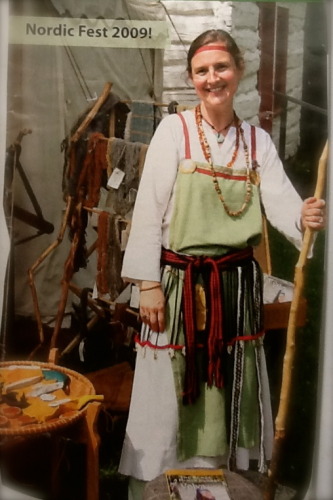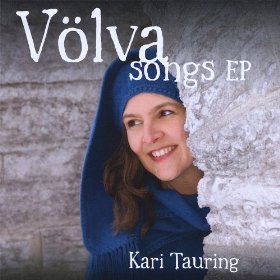
Kari Tauring [Courtesy Photo]
Artist Kari Tauring, who has been exploring these concepts for some time, created a show called Winter Solstice in the Northlands, which she had been staging annually from 1999 to 2006. This December, after an eight year hiatus, she brought the show back to life.
We were able to catch up with Tauring in between her performances to ask her about the production and her background.
For the past twenty years I have worked as a musician and ritual artist, helping others create ceremony around transitional times. I don’t work with any one specific group. I was ordained through the Church of Spiritual Humanism in order to complete ceremonial paperwork [for weddings and other rites of passage]. Most people know me as a Nordic roots musician, story teller, and staff carrier or völva.
Since I grew up in an ethnic enclave of Norwegian Americans, it was natural to begin digging down the root of my folk tradition to find the sources in the very ancient material. I began studying the runes in 1989. Beginning in 2003, I began working with staff and stick (stav and tein) for rhythm, breath, alignment with the world tree, journey and rune song, a spiritual method called ‘volva stav.’ I served Heathenry in the Midwest formally as völva from 2010 until 2014, elected by the council at Midwest Thing held in Kansas. I also serve the Lutheran community as educator and spiritual facilitator. Everyone wants to know what their roots are and see how they connect.”
In December, Tauring told the MinnPost that unlike many solstice and holiday performances, this is not a “family-friendly” show. It is instead designed to be an intense exploration of the darkness. “We’re just told, ‘Everything’s going to be fine, and if you feel empty, just buy more stuff and if you don’t feel good after the holidays it’s because you have to shop better next year,’ ” said Tauring. “But this time of year is an opportunity to, from an ancient Nordic mindset, explore the origins of your own darkness.”
For this production, that means, “It’s not going to be all doom and gloom, but it also helps people to say, ‘It’s okay if you’re not happy at this time of year because this is the height of seasonal effective [sic] disorder; this is the height of not being in a happy place, and it’s okay and here are some tools.'”
Why resurrect the show now, after all this time? For years Tauring also produced family-friendly solstice shows with singing and puppets. She told the MinnPost that her kids are now grown and that she “wanted to shift … from the community-building to something more intense, because it’s been a really intense year with a lot of darkness in it.”
Not surprisingly, some of the tools Tauring uses in the show are runes. She explained a bit about how the tool is incorporated. “Ice and Fire are the first elements of creation in Norse mythology. One of the pieces in this production dealt primarily with the elements of creation and the process of creation and destruction. The runes for ice and fire play an obvious role here. One piece, Avalanche Runedance, was based on a rune stone from Hogganvik, Norway. The alphabet magic/prayers on this stone are really beautiful. I have been working at performing this stone for a few years and in this production I use my musical performance as a sound track for an interpretive dance.”
![[Courtesy Photo]](https://wildhunt.org/wp-content/uploads/2014/12/StavatUU1-300x264.jpg)
Tauring teaching [Courtesy Photo]
The Northern way of dealing with cold and dark is not to fight it. We embrace the sadness. We leave room to feel it. The juletide is a season, not a singular event. It lasted for twenty days in the not so olden times. In modern Scandinavia they still take at least two weeks off to ‘deal’ with the darkness. Another important thing is the lack of future tense . . . Old Norse and Finnish . . . don’t have a future tense, so the way the mind works is different. The names for the ‘fates’ are Is, Becoming, and Should. I am offering an ancient way of ’embracing the void’ and being present in the ‘becoming’ and creating of the past. And a way to be in relationship with the darkness.
Central to the performance, as Taurig presents, is the Norse concept of öorlog, which she defines on her own website as, “the summation of an individual human inheritance (physical, spiritual, ancestral, environmental and cultural).” It carries the experiences, behaviors, traumas, and traditions of our ancestors, and is the basis for the importance of ancestor work in these northern traditions.
She is fond of using a spindle to explain öorlog, writing, “Each of us is born with a spindle of thread spun by parents, grandparents, great-grandparents ad infinitum. This thread is our öorlog. We can not un-spin it, but we can look into it, review it, learn about it, and have memories that surface to help explain why some of the spin is strong and some is thin, lumpy, or even broken and tied back in. We can also choose to spin our strand differently.”
 As this year’s production of Winter Solstice in the Northlands has a more intense focus than in the past, Tauring was able to use it to premiere some of her newest work. For those unable to see the show live, she promised that portions will be available for viewing online in the coming weeks. In addition, her next project, a fourth Nordic roots recording, will include the soundtrack for “Avalanche Runedance.” A Kickstarter campaign to fund that album will be launched in March.
As this year’s production of Winter Solstice in the Northlands has a more intense focus than in the past, Tauring was able to use it to premiere some of her newest work. For those unable to see the show live, she promised that portions will be available for viewing online in the coming weeks. In addition, her next project, a fourth Nordic roots recording, will include the soundtrack for “Avalanche Runedance.” A Kickstarter campaign to fund that album will be launched in March.
The Wild Hunt is not responsible for links to external content.
To join a conversation on this post:
Visit our The Wild Hunt subreddit! Point your favorite browser to https://www.reddit.com/r/The_Wild_Hunt_News/, then click “JOIN”. Make sure to click the bell, too, to be notified of new articles posted to our subreddit.
:/
I don’t really know what to say about this post…While I agree in more or less with the idea of “embracing the darkness” I feel like several pieces of Information presented here are somewhat misleading…
I don’t understand why she repeatedly spells ørlög as öorlog. As far I know, it can be spelled ørlög, örlog or ǫrlog but spelling it öorlog does not convey a proper pronunciation. Her article about the subject is also rather confused and presents Wikipedia as its only source.
I also have no issue with people who bestow upon themselves long-gone magico-religious titles but her article about Völvas is rather confused as well and stretches information taken from written sources to an almost bloated extent. She also doesn’t seem to explain how she studied seiðr, galdr and such “practices” we know very little about.
I also feel like it could have been neat to talk about Skírnismál in the context of the Winter Solstice, IMO it would be much more relevant than talking abou wyrd/ørlög.
One last thing: when it comes to “dealing with the darkness” most Norwegian would rather fly to Gran Canaria than enjoy the ambient darkness and horrid weather :Þ
“most Norwegian would rather fly to Gran Canaria than enjoy the ambient darkness and horrid weather”
Perhaps that shows how disconnected from their traditions they’ve become. I once spent a New Year’s in Norway and found the weather and the very short days delightful!
I have seen a similar comment made elsewhere by someone about a country they had visited recently – not their own – and I feel the same way then reading that as I do now reading yours.
“Perhaps that shows how disconnected from their traditions they’ve become.”
This is really condescending, in a way I am struggling to put across politely. As you said; you spent a single New Year there – you don’t have live there through all the winter; all the cold ones, the dark ones and the miserable ones. To think your single trip is somehow an exemplar and that a people who dont think the same have somehow become “disconnected from their traditions” is all kinds of out of order.
I understand this point of view and would back it as a general rule but in that case I would agree with Finnchuill. Most people in Norway only have a very limited knowledge of their traditional culture, history and Religion. One could extend that to most of Europe/Western world as well.
However, it is true that flying to Gran Canaria might not have anything to do with one’s connection with traditional culture. Maybe lots of Ásatruar also fly to the Tropics every winter (I don’t really know cuz’ I don’t know a single one here). I myself dislike being away from the North during important celebrations but again, I’m not a local, I’m just a ditty immigrant/obsessive fanboy :þ
Where were you in the country? If you talk about nice weather, my guess is that it ain’t the coast!
Fredrikstad (and Oslo). So pretty far south, but compared to where I came from, it was often dark and gloomy. But I personally like what most people call dark and gloomy weather, and am fairly nocturnal. But I do get that most people want their Holidays in the Sun.
Well, it’s always rather cold in winter in and around the Oslofjord. I imagine there must have been quite a lot of snow and sub-zero temperatures. It’s definitely not the case everywhere: right now, from my window I can see half a meter if snow turning into slush and it’s much harder to cope with than all the darkness in the world.
Old Norse and Finnish . . . don’t have a future tense, so the way the mind works is different
While I am a fan of the idea that language and culture/worldview are related, I have to say this kind of assertion leaves me skeptical. It’s fairly common for languages to use tense in different ways than the more commonly known (for an English speaker) Indo-European past-present-future tense system, but in terms of what you might call past/not past, the latter includes both the present and future (off the top of my head, I know that Finnish is like this, as well as the Semitic languages and Japanese). The lack of a grammatical future tense doesn’t mean that the language lacks the ability to talk/think about the future.
JFTR about the future tense, no Germanic language known to me has a synthetic future tense, but only different kinds of analytic ones. And from what I’ve learned about Old Norse/Old Icelandic, an analytic future “works” there, too (appropriate conjugated form of “munu” with infinitive).
See https://en.wikipedia.org/wiki/Future_tense#Icelandic_and_Old_Norse for a reference.
In daily use, at least in German, you often use the present tense while expressing something in the future, e.g. referring to the future using an adverb like “morgen” (tomorrow). So you don’t even need a future tense to express a future concept.
Certainly, and the Germanic languages show a high degree of unique developments in relation to other Indo-European languages iirc. It does seem, though, that among highly inflected IE languages, a future tense is pretty common.
I thought the article was very good and I personally would like to see how Kari would recommend working through the “dark”.